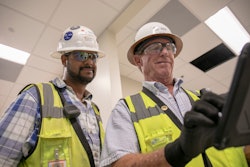
The general session was full Tuesday, September 27 at New Orleans’ Ernest N. Morial Convention Center as 9,000 participants were on hand to soak up the latest product insights at Autodesk University 2022, attend education sessions on Autodesk’s product offerings and see what partners were offering to extend these solutions.
As Autodesk CEO Andrew Anagnost kicked off the event, he hit a lot of highlights for the construction industry—including the company’s newly-announced FORMA cloud—a shared data repository for project data that can be shared with various stakeholders collaborating on a project and follow an asset through its lifecycle. The goal is to unify building information modeling (BIM) workflows for designers, contractors and project owners.
Autodesk has already taken steps in this direction with the Autodesk Bridge tool for Autodesk Construction Cloud. Bridge enables parties to a project to share files and Sheets, either generically across project collaborators or with specific groups or individuals. Sheets are two-dimensional drawings in Autodesk Build that can be enriched with hyperlinked callouts and markup capabilities. Documents, most commonly PDF files, can be uploaded to Autodesk Build and converted to Sheets.
At Autodesk University 2022, the company also announced new features for Autodesk Construction Cloud and Autodesk Tandem for facilities managers. New tools in each product make BIM data more accessible and useful for contractors and facilities management professionals, respectively. The IronPros product analysis site has exclusive insights on what Autodesk launched for Autodesk Construction Cloud and Autodesk Tandem that sheds light on what these new announcements mean. But the overarching initiative to help this BIM data cross organizational and functional boundaries will be Forma.
“With labor shortages, supply chain disruptions and the pandemic, we have all experienced difficulties over the last few years and learned lessons,” Anagnost said. “We have to be willing to change how we do things. We all need to be more connected, more agile and more resilient. We need to acknowledge that how we did things in the past will not work in the future. We see a lot of you embracing digital transformation and connecting your processes and your people. The way you all collaborate has changed and it has changed forever …There are many tools you all use today from so many providers—some of them are closed and leave your processes disconnected. So, you have to pass huge files back and forth and if you do that, you often overshare your IP. Oversharing can get people in trouble, so data gets lost in translation. When data and processes are disconnected, unique insights get lost.”
The overarching goal of Forma, along with its counterparts, Flow for the creative industry and Fusion for manufacturing, is to provide an open, easily manageable data foundation that enables project stakeholders to access the relevant data for their part of the project without accessing the entirety of what could be a multi-faceted project with elements that may be proprietary or confidential.
“Forma will transform early stage planning upstream, but will reach downstream,” Anagnost said. “…Our customers will be able to unlock design data and exchange it with external products as a native capability in Forma. So, an engineering company writing terrain data to the cloud can collaborate with external companies on corridor and alignment designs, sharing just the terrain data they need to collaborate.”
New Features in Autodesk Build
Bridge was announced as a new native feature along with about 300 other new features announced year-to-date in 2022—including 153 new features in Autodesk Build alone. In one session, Autodesk Product Managers laid out these enhancements most of interest to contractors:
In functionality for requests for information, Autodesk Build users can now reply to an RFI by email even if they have no license for the software. This speeds up response times and makes it easier to involve more members of a project team.
Users can now also create different RFI Types and choose between workflows with one or multiple reviewers or coordinators. This automates the review process, standardizes RFIs with multiple stakeholders and enables users to control who sees what parts of a project.
Submittals also receive new custom workflow functionality, and like RFIs, users can now add multiple review steps and one or more reviewer per step. This makes for a more flexible process, enhanced accountability and gives users the ability to easily track who approved what.
In schedule management, Autodesk adds the ability to notify key stakeholders when a new version of the schedule is published. This is a highly configurable feature, and users can set a narrative and a distribution list to determine who is notified under what circumstances.
The schedule also features historical version logs to make it easy to view how the schedule has changed over time. The ability to compare versions of a schedule is also forward-looking—users can compare up to five different versions of a schedule in a what-if analysis to spot how different changes will result in delays. Users can share filtered views of the schedule with stakeholders, echoing Anagnost’s messaging about control over who can see what and avoiding oversharing.
Autodesk Build still relies on an external project schedule like Oracle Primavera P6 or Microsoft Project—scheduling is a newer feature set in the product.
The meetings tool in Autodesk Build gets enhancements for mobile—iOS users can now create new meetings topics and use other functions formerly reserved for the web interface.
Cost management improvements give self-performing contractors tools to analyze productivity and cost data directly in cost management for real time visibility into potential risk and to make forecast adjustments. Through integrations with field management software products including RiskCast, Struxi, Rhumbix and Quickbooks Time and Clickup, Autodesk Build users can bring in items from the budget and see hours per unit and break project performance data down into instances to see if work performed on specific locations, by specific crews or on different projects are performance outliers to spot emerging issues in parts of a project.
Estimators will be interested in a new ProEst integration, which exposes estimates from the software product acquired by Autodesk in December of 2021. Once a ProEst estimate is accepted, users can convert final estimate into the project budget within the cost management tool.
In the Assets tab in Autodesk Build, users get new model-based workflows. They can now extract and map asset and equipment information from a model so that teams can start visually tracking assets.
What’s next for Autodesk Build
Even more new capabilities will be shipped in the weeks to come, according to session presenters.
RFIs will also soon be betting the ability to add multiple reviewers, similar to what is now released for submittals.
Correspondence—a brand new tool, captures email correspondence in the platform to centralize information about RFIs and submittals.
Also coming soon is a Work plan, a short-term planning tool to facilitate lean construction principles--longer term planning will still be the domain of the planning tool.
Functionality for multiple currencies is also coming to Autodesk Build. This will cut across contracts, change orders, payment applications and expenses. A currency of record can be established in the application, and as gain and loss calculations are realized or unrealized, they are translated back into the core currency. There will also be a tool to surface risks to the project from currency fluctuations.
In the photo gallery, Autodesk Build users will gain new permissions controls for photos. Again, to prevent oversharing of data, an administrative user can control who accesses photos with contextual tools from RFIs, Forms and issues.
During project handover, Autodesk Build users will be able to leverage a tool that streamlines commissioning and handover documentation, providing owners with a comprehensive and accessible view of the project.
Users relying on Autodesk Build assets and progress tracking can now drill down from visual representations of project and activity status to the underlying data set feeding into that performance.


















